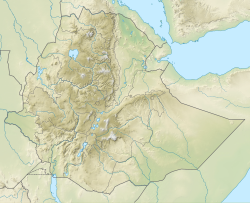 | |
| Location | Gondar, Amhara Region, Ethiopia |
|---|---|
| Coordinates | 12°36′27″N 37°28′12″E / 12.60750°N 37.47000°E |
| History | |
| Builder | Fasilides |
| Founded | 1645 |
| Official name | Fasil Ghebbi, Gondar Region |
| Type | Cultural |
| Criteria | (ii), (iii) |
| Designated | 1979 (3rd session) |
| Reference no. | 19 |
| Region | Africa |
The Fasil Ghebbi (Amharic: ፋሲል ግቢ) is a fortress located in Gondar, Amhara Region, Ethiopia. It was founded in the 17th century by Emperor Fasilides and was the home of Ethiopian emperors. Its unique architecture shows diverse influences including Portuguese, Hindu, and Arab characteristics.[1] Because of its historical importance and architecture, the fortress was inscribed as a UNESCO World Heritage Site in 1979.[1] Ghebbi is an Amharic word for a compound or enclosure.[2]
The complex of buildings includes Fasilides' castle, Iyasu I's palace, Dawit III's Hall, Empress Mentewab's castle, a chancellery and library from Yohannes I, a banqueting hall from the emperor Bakaffa, stables, and three churches: Asasame Qeddus Mikael, Elfign Giyorgis and Gemjabet Mariyam.[1]
- ^ a b c "Fasil Ghebbi, Gondar Region". UNESCO World Heritage Centre. United Nations Educational, Scientific, and Cultural Organization. Retrieved 18 September 2021.
In the 16th and 17th centuries, the fortress-city of Fasil Ghebbi was the residence of the Ethiopian emperor Fasilides and his successors. Surrounded by a 900-m-long wall, the city contains palaces, churches, monasteries and unique public and private buildings marked by Hindu and Arab influences, subsequently transformed by the Baroque style brought to Gondar by the Jesuit missionaries.
- ^ Appleyard, David (2013). Colloquial Amharic (2nd ed.). Routledge. ISBN 9781136303036.
